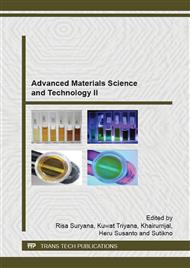[1]
Z. W. Liu, H. Y. Huang, X. X. Gao, H. Y. Yu, X. C. Zhong, J. Zhu, D. C. Zeng, Microstructure and property evolution of isotropic and anisotropic NdFeB magnets fabricated from nanocrystalline ribbons by spark plasma sintering and hot deformation, Journal of Physics D: Applied Physics 44 (2011).
DOI: 10.1088/0022-3727/44/2/025003
Google Scholar
[2]
J. Li, Y. Liu, �S.J. Gao, M. Li, Y.Q. Wang, M.J. Tu, Effect of process on the magnetic properties of bonded NdFeB magnet, Journal of Magnetism and Magnetic Materials 299 (2006) 195-204.
DOI: 10.1016/j.jmmm.2005.03.094
Google Scholar
[3]
N. Hamada, C. Mishima, H. Mitarai, Y. Honkura, Development of Nd-Fe-B anisotropic bonded magnet with 27 MGOe, IEEE Transaction on Magnetics and Magnetism 39(5) (2003) 2953-2955.
DOI: 10.1109/tmag.2003.815757
Google Scholar
[4]
N. V. Vuong, N. V. Khanh, D. M. Thuy, Simulation of the energy product (BH)max of Nd-Fe-B anisotropic bonded magnets, Physica B 327 (2003) 349-351.
DOI: 10.1016/s0921-4526(02)01784-2
Google Scholar
[5]
K. Uestuener, M. Katter, W. Rodewald, Dependence of the mean grain size and coercivity of sintered Nd-Fe-B magnets on the initial powder particle size, IEEE Transaction on Magnetics and Magnetism 42 (2006) 2897-2900.
DOI: 10.1109/tmag.2006.879889
Google Scholar
[6]
W. Rodewald, M. Katter and K. Uestuener, Coercivity and mechanical properties of Nd-Fe-B magnets in dependence on the average grain size, 18th Int. Workshop on High Performance Magnets and Their Applications, Annecy (2004) 486-492.
DOI: 10.1109/intmag.2006.375810
Google Scholar
[7]
H. Nakamura, K. Hirota, M. Shimao, T. Minowa, M. Honshima, Magnetic properties of extremly small Nd-Fe-B sintered magnets, IEEE Transaction on Magnetics and Magnetism 41 (2005) 3844-3846.
DOI: 10.1109/tmag.2005.854874
Google Scholar
[8]
J. Xiao, J. Otaigbe, Polymer-bonded magnets III. Effect of surface modification and particle size on the improved oxidation and corrosion resistance of magnetic rare earth fillers, Journal of Alloys and Compounds 309 (2000) 100–106.
DOI: 10.1016/s0925-8388(00)01060-4
Google Scholar
[9]
X.H. Zhang, W.H. Xiong, Y.F. Li, N. Song, Effect of process on the magnetic and mechanical properties of Nd–Fe–B bonded magnets. Materials and Design 30 (2009) 1386-1390.
DOI: 10.1016/j.matdes.2008.06.062
Google Scholar
[10]
F. Zhai, A. Sun, D. Yuan, J. Wang, S. Wu, A.A. Volinsky, Z. Wang, Epoxy resin effect on anisotropic Nd-Fe-B rubber-bonded magnets performance, Journal of Alloys and Compounds 509 (2011) 687-690.
DOI: 10.1016/j.jallcom.2010.09.210
Google Scholar
[11]
E.A. Pèrigo, M.F. de Campos, R.N. Faria, F.J.G. Landgraf, The effect of the pressing step on the microstructure and aging of the NdFeB bonded magnets, Powder Technology 224 (2012) 291-296.
DOI: 10.1016/j.powtec.2012.03.010
Google Scholar


